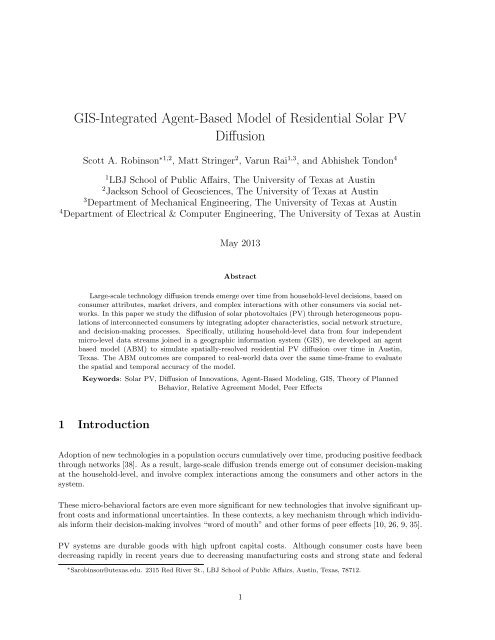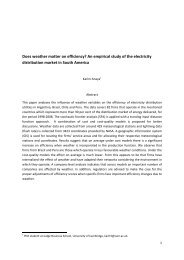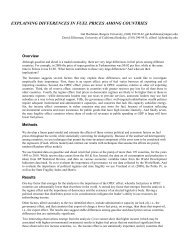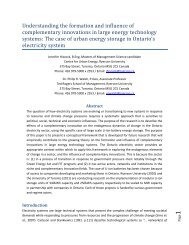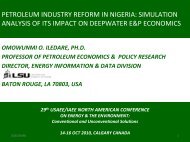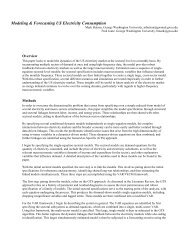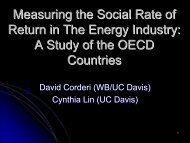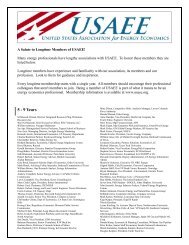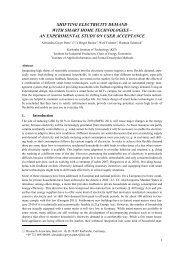GIS-Integrated Agent-Based Model of Residential Solar PV Diffusion
GIS-Integrated Agent-Based Model of Residential Solar PV Diffusion
GIS-Integrated Agent-Based Model of Residential Solar PV Diffusion
- No tags were found...
Create successful ePaper yourself
Turn your PDF publications into a flip-book with our unique Google optimized e-Paper software.
Figure 1: Two ABMs used in this study. The left model was created using grid topology in Repast,and assumes agents are distributed on a homogenous unbroken surface. The right model was created in<strong>Agent</strong> Analyst, and shows realistic agent distribution. <strong>Solar</strong> <strong>PV</strong> adopters are shown in green, with arrowsillustrating one agents network. Opinion <strong>of</strong> solar is displayed in red-scale.1.2.2 <strong>Agent</strong>-<strong>Based</strong> <strong>Model</strong>ing<strong>Agent</strong>-based modeling has emerged as an effective way to model complex processes involving spatialdifferences in the underlying diffusion drivers like interaction effects [12]. <strong>Agent</strong>-based models (ABMs)consist <strong>of</strong> three basic elements: one or more sets <strong>of</strong> agents, the environment in which the agents interact,and the rules and relationships that guide agent behavior [29]. The sum <strong>of</strong> agent and environment statesat the end <strong>of</strong> the simulation determines the model outcome. By explicitly coding the decision rules foragents, these models allow researchers to probe the individual processes that lead to aggregate results,such as cumulative market penetration [12, 29, 3]. ABMs have generated significantly different resultsthan traditional methods partly because they capture the heterogeneity <strong>of</strong> individual agent decisionmakingprocess [34]. Furthermore, the coupling <strong>of</strong> ABMs to <strong>GIS</strong> allows for greater precision by allowingagents to interact on a real topology (figure 1).1.3 Research ObjectivesOur main objective is to build an integrated model capable <strong>of</strong> forecasting spatially-resolved <strong>PV</strong> adoptionscenarios in any study-area for which certain socio-demographic, micro-behavioral, and contextual(electricity rates, etc.) data are available. The hope is that such an integrated bottom-up model willbe able to inform the design <strong>of</strong> incentive structures, identify future markets, and better integrate <strong>PV</strong>in the electric grid by more accurately assessing infrastructure implications at the local level. Workingtowards that overarching goal, in this paper we use an agent-based model (ABM) integrated geospatiallywith Arc<strong>GIS</strong> 10 R○ to simulate the diffusion <strong>of</strong> residential <strong>PV</strong> in Austin, Texas. Specifically, our effort inthis paper is two-fold: 1. build and integrate an ABM with <strong>GIS</strong> functionality, and 2. use the model toexplore some basic hypotheses regarding consumer behavior and associated network interactions withinthe context <strong>of</strong> the residential <strong>PV</strong> sector. On the latter, our interest is in exploring the impact <strong>of</strong> threethings in particular on <strong>PV</strong> diffusion: (i) social, economic, demographic and behavioral attributes associatedwith current/future solar <strong>PV</strong> adopters ; (ii) structure and strength <strong>of</strong> information networks;and (iii) the role <strong>of</strong> extreme opinion holding agents–households that have strong and extreme opinions(positive or negative) about <strong>PV</strong>. The focus throughout is on model development, the data to inform themodel, and the validation methods used to compare model results with real-world data. The conclusionsthemselves are preliminary and exploratory in nature.3
Figure 3: From Watts (2004) [44]. Three conceptions <strong>of</strong> network connections between nodes. Small worldnetworks are shown in the center.2.3 Size and Scope <strong>of</strong> the <strong>Model</strong>Austin has the highest number <strong>of</strong> <strong>PV</strong> installations in Texas, lending greater statistical power to thevalidation <strong>of</strong> the ABM. Despite this, adoption rates are far below the potential market, which is roughlyestimated to be 25% <strong>of</strong> residential households [46]. From spring 2005 to summer 2012, 1,750 <strong>of</strong> the170,000 households in the City <strong>of</strong> Austin area have installed <strong>PV</strong> systems, representing a compoundannual growth rate (CAGR) <strong>of</strong> 35.6%. Even though adoption is increasing, total market penetration isonly 0.9% <strong>of</strong> all residential households.As the primary goal <strong>of</strong> this paper is to lay out the development <strong>of</strong> the integrated modeling framework, forthe empirical tests reported in this paper we chose to keep the spatial scale limited, while still allowingfor a high granularity <strong>of</strong> agent networks. Specifically, we focused on a single zip code within the AustinEnergy Service Area. This subsample involves the interaction <strong>of</strong> nearly 7,700 agents (households) out <strong>of</strong>the more than 170,000 households in Austin.2.4 <strong>Model</strong> StructureThe model was initialized with empirical household-level data from the Austin Energy <strong>Solar</strong> Rebateprogram from January 1, 2005 to the program data midpoint–January 1, 2008. Then the model resultstest runs from the midpoint to the 2nd quarter 2012 were compared against empirical results.Data streams 1-4 (see Section 3 for details) were incorporated into the ABM according to the modeldiagram in figure B.1. The figure also shows the function hierarchy and relevant variables at the modeland agent level. Broadly, the intention is driven by the relative agreement function within small worldnetworks. After reaching intention to install, adopters will assess payback and wealth to determine theadoption decision.2.5 InitializationThe ABM design is shown in figure B.1. The model was initialized to reflect the “ground truth” as<strong>of</strong> 1/1/2008 as closely as possible. Small world networks were created for each agent by dividing allhouseholds into neighbor and non-neighbor sets according to their actual location in the study area. 95%6
Figure 4: Flowchart <strong>of</strong> an agent’s decision process. following the framework from the Theory <strong>of</strong> PlannedBehavior. The intention threshold is set at 0.667. Physical compatibility is determined randomly, with aprobability <strong>of</strong> 0.75.1 Financial capability is determined by market value <strong>of</strong> the house, a proxy for wealth(see text for details).<strong>of</strong> network contacts were drawn from the neighbors set, and 5% were drawn randomly from the nonneighborsset. Because we did not have comprehensive information about opinion levels regarding solaramong non-adopters, opinion between -1 and 1 and uncertainty between 0 and 2 (x, u, in equation 1) areassigned according to a normal distribution. <strong>PV</strong> adopters were initialized in the model to reflect actualadoption status on an individual basis as <strong>of</strong> 1/1/2008. Each household was assigned a threshold paybackperiod, drawn randomly from a distribution <strong>of</strong> payback periods generated by the “Very optimistic(Scenario 5)” <strong>of</strong> the financial model described in Rai and Sigrin (2013). This scenario was described bythe authors as the best estimate <strong>of</strong> <strong>PV</strong> “buyer” decision-making [37].2.6 <strong>Model</strong> Quarterly CycleIn the model, each cycle is equivalent to one fiscal quarter, in which each agent follows the process shownin figure 4. Once the household becomes an adopter, x and u are fixed at 1, and 0.001 respectively torepresent the very high general satisfaction <strong>PV</strong> owners report with their systems [35]. <strong>Agent</strong> interactionsare represented by small world networks (see Section 2.2). The local set is created as a function <strong>of</strong> spatialcontiguity or distance, which is calculated in Arc<strong>GIS</strong> R○ . Household intention to adopt <strong>PV</strong> is a dynamicvariable, altered by the relative agreement function within the agent’s small world network. In orderto assess “perceived control” construct <strong>of</strong> TPB, a household compares the empirical payback for thequarter to the household’s payback threshold.<strong>Solar</strong> <strong>PV</strong> adopters’ home values are consistently above the aggregate median home value ( $190,000);7
however, the median home value <strong>of</strong> adopters has decreased from $391,00 to $371,000 from 2008 to 2012.Logistic regression was used to calculate the odds <strong>of</strong> a household adopting solar <strong>PV</strong> in Austin accordingto equation 6, where n is the number <strong>of</strong> households, Nei is the number <strong>of</strong> adopters within 1500ft, gis the home value decile, and HV C is a binary variable for each home value decile g. Empirically, wefind that the odds <strong>of</strong> adoption depend significantly on market value deciles , with higher odds for highermarket value deciles (results not shown here). This information is used to initialize the opinion thresholdfor agents depending on their wealth–thus, the opinion threshold <strong>of</strong> a household in the highest homevalue decile (> $510k) has an opinion threshold roughly 5 times higher than an equivalent household isthe 5 th home value decile ($166k-$193k). In future work, we will explore other model constructs thatemploy this empirical observation (odds <strong>of</strong> adoption depending on home value/wealth) more directly,for example by using it to initialize the payback thresholds.Adopt i =1 + e −(β0+ n ∑1∑( 10β gHV C g) i+β 2Nei i)i=1 g=1(6)2.7 <strong>Model</strong> EvaluationEach batch <strong>of</strong> the ABM was evaluated against empirical data in two ways: over time through deviation(RMSE) in marginal quarterly and cumulative quarterly adoption, and over space through spatial autocorrelationmapping <strong>of</strong> adopters. <strong>Model</strong>s were said to perform better with lower RMSE, and a largernumber <strong>of</strong> matching spatial hot-spots.2.7.1 Root Mean Squared ErrorResiduals for the marginal number <strong>of</strong> new adopters and the cumulative number <strong>of</strong> adopters were calculatedby subtracting the model output for a given quarter from the empirical outcome in the samequarter. The deviation, or root mean squared error (RMSE) <strong>of</strong> the model was calculated accordingly,where q is a given quarter, â is the number <strong>of</strong> adopters in the model, and a is the number <strong>of</strong> adoptersin the empirical data:n∑RMSE = √ ( (â − a q) 2) (7)nq=1We assume that models with lower deviation more accurately represent the reality <strong>of</strong> aggregate consumerdecision-making processes.2.8 Hot-Spot AnalysisWe evaluated areas within the study area that empirically displayed clustering <strong>of</strong> <strong>PV</strong> adopters comparedto where these clusters were predicted by the ABM. To do this we divided the study area into 4000ftx 4000ft cells, and performed hot-spot analysis using the Getis-Ord G ∗ i test statistic to generate localestimates for significant spatial autocorrelation along 2000ft distance bands, where w ij is the spatialweight between cell i and cell j, x j is the number <strong>of</strong> adopters in that cell, ¯X is the mean number <strong>of</strong>8
adopters for each cell, and S is the standard deviation:G ∗ i =n∑(w i,j x j ) − ¯X ∑ nj=1S√w i,jj=1n∑wi,j 2 −( ∑ n w i,j) 2j=1j=1n−1(8)The G ∗ i scores calculated from the empirical data are then compared to those generated in the ABM viacontingency tables. The full empirical results are shown in figure C.1.3 DataTo allow for a high degree <strong>of</strong> fidelity in calculating individual agent decision thresholds, social networks,and financial threshold values in the ABM– empirical data used in the model is individual household-leveldata for every home in Austin, Texas. Thus, each household agent in the model corresponds to a specifichousehold on the ground. This allowed for precise initialization and evaluation <strong>of</strong> the ABM. Below arethe five distinct data streams used: 1) <strong>Solar</strong> program data for <strong>PV</strong> adopters in Austin Energy servicearea, including size, cost, date, and other technical features <strong>of</strong> the installed <strong>PV</strong> systems. 2) Home valuesand land use type for all properties in the Austin Energy Service Area provided by the Travis CentralAppraisal District, the county serviced by Austin Energy. 3) A household-level survey <strong>of</strong> Texas solar <strong>PV</strong>owners, described in detail in Rai and McAndrews (2012) [35]. 4) Individual electricity consumption,utility rates, and <strong>PV</strong> system electricity generation with time-<strong>of</strong>-day and monthly variations, used tocalculate household discount rates and associated payback periods [37]. 5) A <strong>GIS</strong> created using datafrom the Travis County Appraisal District storing the geographic coordinates <strong>of</strong> all residential parcelslocated in Travis County. This was used to join data streams 1-4 through geocoding in Arc<strong>GIS</strong> R○ .4 ResultsIn this section we present preliminary results based on some exploratory scenarios (batches). Discussedbelow are the main results from batches (2, 10, 18, 19, 20, 22) that illustrate several important sensitivities.Key parameters and description <strong>of</strong> these batches are provided in Table 1. Complete sensitivitytesting for the entire range <strong>of</strong> each parameter is still underway.9
Table 1: Key parameters and descriptions <strong>of</strong> several <strong>of</strong> the batches used in this study. All batch parametersare relative to those shown for Batch 19. <strong>Model</strong> design shown in figure B.1.ABM Sensitivity Batch DefinitionsBatch Parameters Description19210182022µ = 0.7, u ∝ x,90% locals, monthly RA ∗ , Baselineradial neighborhoodsNo EOHs: <strong>PV</strong> adoptersx ⊥ udo not have strongerinfluence on opinionLocal networks arecontiguous neighborhoods defined by the eightnearest neighbors only<strong>Agent</strong>s interact fourRA ∗times each quarterrather than threeEach interactionµ = 0.5 has less potentialto change opinionMore social network80% locals connections are non-localand occur randomly* RA refers to the number <strong>of</strong> times an agent interacts through relative agreement algorithm.4.1 Root Mean Squared Error EvaluationRMSE was calculated for the marginal (quarterly) rate <strong>of</strong> adoption, and cumulative quarterly number<strong>of</strong> adopters as market percentage for each batch. Batch 19, which displayed the least deviation frommarginal empirical adoption rates was used as a baseline model. Batch 19 used a µ <strong>of</strong> 0.7, u distributedproportionally to x, a local neighborhood set defined as households within 1500ft <strong>of</strong> the target agent,small world networks made up <strong>of</strong> 90% locals, and agents interacting monthly (three times per quarter).Table 2: RMSE calculated for marginal (quarterly) and cumulative (market percentage) adoption rates.Batch scores are tabulated each quarter, over 100 runs.RMSEBatch Quarterly Adoption Market Percentage2 5.69 0.5210 5.27 0.3018 12.75 1.6519 3.76 0.2420 5.46 0.4822 5.41 0.4610
Batch 2 distributed uncertainty (u) independently <strong>of</strong> opinion (x). This illustrates a scenario whereextreme opinion holders are not present in the population. Batch 10 used local neighborhood sets definedby geometric contiguity: neighbors were limited to the eight households surrounding the agent. Batch18 allowed for increased interaction among agents each quarter. Batch 20 weighted each interaction lessheavily (mu 0.5). Batch 22 decreased the proportion <strong>of</strong> locals within the agent’s network to 80%. Toshow the deviation reported in table 2 in context, figure 5 uses local polynomial regression to linearize thebatch data and better illustrate each batch <strong>of</strong> 100 model runs against the empirical cumulative adoptionlevels in the study area–showing not only the overall error in the batch, but the sign and temporallocation <strong>of</strong> deviation.4.1.1 Hot-Spot EvaluationHot-spots are defined as areas (polygons) which display statistically significant clustering, or autocorrelationover space. The polygons used for this analysis are 4000ft x 4000 ft. square cells, creating a gridover the study area. <strong>Model</strong>s are assumed to be more accurate if they generate identical clusters as theempirical data (shown for all <strong>of</strong> Austin in figure C.1). A positive match is defined as an area with astandardized G ∗ i Z score <strong>of</strong> two standard deviations or more from the mean (0) both in the empirical dataset and in the ABM batch. A negative is defined as less than two standard deviations from the mean.Thus, marginally significant areas (shown in light red) were counted as negatives. Only polygons with atleast 75% <strong>of</strong> their total area within the study area were counted, because clustering effects within thesepolygons in the empirical data are influenced by households outside the zip code study area boundary.Contingency tables were used to analyze the results. Empirical data shows three instances <strong>of</strong> positiveclustering, and 28 instances without significant clustering (negative). Figure 6 displays mapped resultsfor selected batches.Batches 2, 10, and 20 showed the most accuracy in correctly predicting areas with high spatial autocorrelationwithin the studied zip code. These batches correctly predicted the three empirical hot-spots andgenerated no hot-spots that were not reflected in the empirical data. Batch 18 was the least accurate,generating three clusters not seen in empirical data, and correctly predicting none. Batch 19 generatedto true positives and one false positive.5 ConclusionGeographically-referenced ABM <strong>of</strong>fers insight into consumer decision-making by allowing for more precisemodel specification and evaluation. Using two specific theoretical representations <strong>of</strong> the components<strong>of</strong> consumer interactions–small world networks for the structure and relative agreement model as themechanism–we demonstrate the potential to model consumer information exchange and the resultingaffect on technology diffusion. The model can potentially be replicated in other study areas with accessto time series data on adopter payback, geographically-referenced, time-series solar adoption data,household-level data, and accurate land parcel shapefiles. The two levels <strong>of</strong> evaluation used in this studysuggest that there is value in using <strong>GIS</strong>-integrated ABM to predict solar diffusion in urban areas. Thegenerally low RMSEs generated by the ABM suggests that the chosen framework, relative agreementthrough small world networks, moderated by payback period evaluation and home value may be representative<strong>of</strong> real-world adopter decision-making. Through analysis <strong>of</strong> empirical data, we find that homevalue, and number <strong>of</strong> existing adopters within 1500ft are significant explanatory variables in calculatingthe odds that a given household will adopt solar <strong>PV</strong> technology. Sensitivity testing <strong>of</strong> the ABM lends11
Figure 5: Local polynomial regression fit lines for five model run batches. The yellow curve shows empiricaladoption rates. Batch 18 is not shown, as this batch greatly overestimated adoption levels, making visualinterpretation <strong>of</strong> the other batches more difficult). Shaded areas show 95% confidence intervals.12
Figure 6: Mapping hot-spots in the study area for empirical data (top left) and selected batches. Dark redshows significant clustering, light red shows marginally significant clustering, and blue shows no clustering.support to the structure and strength <strong>of</strong> communications (peer-to-peer) networks as significant drivers<strong>of</strong> diffusion patterns. Within the model, higher values <strong>of</strong> µ, which controls the weight <strong>of</strong> each interaction,result in higher adoption levels. In the selected batches described in this paper, batch 2, andbatch 20 have lower µ (0.5), and display the lowest cumulative adoption rates. This relationship remainstrue through the full tested range <strong>of</strong> the variable (0-1). Looser networks–those with more non-localconnections, also displayed decreased adoption levels along the tested range (25%-95%).With our initial exploratory scenarios and sensitivity analyses we are unable to find conclusive resultson the role <strong>of</strong> extreme opinion holders in the diffusion process <strong>of</strong> <strong>PV</strong>. Allowing adopters to act as EOHsin the model reduced RMSE, but did not appear to affect the spatial accuracy <strong>of</strong> the model. Furtherwork is needed to evaluate this hypothesis fully.6 Future WorkFuture work will include complete sensitivity on all model parameters, even those estimated from empiricaldata. Future models will include supply-side agents (installers, contractors, etc.), who use variousmarketing techniques to push technologies into the marketplace. In addition to creating more realisticagent interactions, this will allow for the testing and assessment <strong>of</strong> competing business strategies withina dynamic marketplace. We will also seek to incorporate varying environment-level variables, such asvarying policy structures and market seasonality.13
Currently, our ABM uses the relative agreement function within the TPB to model agent interactions.Alternative decision models such as the sequential choice model [40], and trust-based models [24] couldbe examined and tested in the context <strong>of</strong> residential solar <strong>PV</strong>.Network topology plays a large role in adoption outcomes. To improve the extra-local connections inthe small world networks are randomly generated. Future work will seek to empirically derive non-localconnections.References[1] I. Ajzen. The theory <strong>of</strong> planned behavior. Organizational behavior and human decision processes,50(2):179–211, 1991.[2] I. Ajzen. Perceived behavioral control, self-efficacy, locus <strong>of</strong> control, and the Theory <strong>of</strong> PlannedBehavior. Journal <strong>of</strong> Applied Social Psychology, 32(4):665–683, 2002.[3] S.J. Alam and A. Geller. Networks in agent-based social simulation. In A.J.: Heppenstall, A.T.;Crooks, L.M.; See, and M. Batty, editors, <strong>Agent</strong>-<strong>Based</strong> <strong>Model</strong>s <strong>of</strong> Geographical Systems, pages199–216. Springer, 2012.[4] G. Barbose, N. Darghouth, and R. Wiser. Tracking the sun v: An historical summary <strong>of</strong> theinstalled cost <strong>of</strong> photovoltaics in the United States from 1998 to 2011. Lawrence Berkeley NationalLaboratory, 2012.[5] F.M. Bass. A simultaneous equation regression study <strong>of</strong> advertising and sales <strong>of</strong> cigarettes. Journal<strong>of</strong> Marketing Research, 6(3):291–300, 1969.[6] M. Baziliana, M.L. Ijeoma Onyejia, I. MacGilld, J. Chasec, J. Shahe, D. Gielenf, D. Arentg, D. Landfearh,and S. Zhengrongi. Re-considering the economics <strong>of</strong> photovoltaic power. Blomberg NEF: NewYork, USA, 2012.[7] S. E. Beatty and S.M. Smith. External search effort: An investigation across several productcategories. Journal <strong>of</strong> Consumer Research, 14(1):83–95, 1987.[8] S. C. Bhargava, A. Kumar, and A. Mukherjee. A stochastic cellular automata model <strong>of</strong> innovationdiffusion. Technological Forecasting and Social Change, 44(1):87–97, 8// 1993.[9] B. Bollinger and K. Gillingham. Peer effects in the diffusion <strong>of</strong> solar photovoltaic panels. MarketingScience, 31(6):800–812, 2012.[10] J. J. Brown and P. H. Reingen. Social ties and word-<strong>of</strong>-mouth referral behavior. Journal <strong>of</strong> ConsumerResearch, 14(3):350–362, 1987.[11] N. Collier. Repast: An extensible framework for agent simulation. The University <strong>of</strong> Chicago’sSocial Science Research, 36, 2003.14
[12] A.T. Crooks and A.J. Heppenstall. Introduction to agent-based modelling. <strong>Agent</strong>-based models <strong>of</strong>geographical systems, pages 85–105, 2012.[13] G. Deffuant, F. Amblard, G. Weisbuch, and T. Faure. How can extremism prevail? a study basedon the relative agreement interaction model. Journal <strong>of</strong> Artificial Societies and Social Simulation,5(4), 2002.[14] G. Deffuant, S. Huet, and F. Amblard. An individual based model <strong>of</strong> innovation diffusion: Mixingsocial value and individual benefit. American Journal <strong>of</strong> Sociology, 110(4):1041–1069, 2005.[15] G. Deffuant, D. Neau, F. Amblard, and G. Weisbuch. Mixing beliefs among interacting agents.Advances in Complex Systems, 3(1):87–98, 2000.[16] A. Faiers and C. Neame. Consumer attitudes towards domestic solar power systems. Energy Policy,34(14):1797–1806, 9// 2006.[17] A. Getis and J K. Ord. The analysis <strong>of</strong> spatial association by use <strong>of</strong> distance statistics. Geographicalanalysis, 24(3):189–206, 1992.[18] A. N. Giovanis and C. H. Skiadas. A stochastic logistic innovation diffusion model studying theelectricity consumption in Greece and the United States. Technological Forecasting and SocialChange, 61(3):235–246, 7// 1999.[19] R. Hegselmann and U. Krause. Opinion dynamics and bounded confidence models, analysis, andsimulation. Journal <strong>of</strong> Artificial Societies and Social Simulation, 5(3), 2002.[20] A. B. Jaffe, R.G. Newell, and R.N. Stavins. A tale <strong>of</strong> two market failures: Technology and environmentalpolicy. Ecological Economics, 54(23):164–174, 8/1/ 2005.[21] A. B. Jaffe and R. N. Stavins. Dynamic incentives <strong>of</strong> environmental regulations: The effects <strong>of</strong>alternative policy instruments on technology diffusion. Journal <strong>of</strong> Environmental Economics andManagement, 29(3):S43–S63, 11// 1995.[22] K. M. Johnston, M.J. North, and D.G. Brown. <strong>Agent</strong> Analyst: <strong>Agent</strong> <strong>Based</strong> <strong>Model</strong>ing in Arc<strong>GIS</strong>.ESRI Press, Redlands, California, 1 edition, 2013 2013.[23] P. Kaufmann, S. Stagl, and D.W. Franks. Simulating the diffusion <strong>of</strong> organic farming practices intwo new EU member states. Ecological Economics, 68(10):2580–2593, 8/15/ 2009.[24] D.J. Kim, D.L. Ferrin, and H.R. Rao. A trust-based consumer decision-making model in electroniccommerce: The role <strong>of</strong> trust, perceived risk, and their antecedents. Decision Support Systems,44(2):544–564, 1// 2008.[25] L. Klein and G. Ford. Consumer search for information in the digital age: An empirical study <strong>of</strong>prepurchase search for automobiles. Journal <strong>of</strong> Interactive Marketing, 17(3):29–49, // 2003.[26] S. Krishnamurthy. A comprehensive analysis <strong>of</strong> permission marketing. Journal <strong>of</strong> Computer-Mediated Communication, 6(2):0–0, 2001.15
[27] C. L. Kwan. Influence <strong>of</strong> local environmental, social, economic and political variables on the spatialdistribution <strong>of</strong> residential solar <strong>PV</strong> arrays across the United States. Energy Policy, 47(0):332–344,8// 2012.[28] V. Lacy, R. Matley, and J. Newcomb. Net energy metering, zero net energy and the distributedenergy resource future: Adapting electricity utility business models for the 21 st Century. Technicalreport, Rocky Mountain Institute, Boulder, CO, 2012.[29] C.M. Macal and M.J. North. Tutorial on agent-based modelling and simulation. Journal <strong>of</strong> Simulation,4(3):151–162, 2010.[30] M. Meadows and D. Cliff. Reexamining the relative agreement model <strong>of</strong> opinion dynamics. Journal<strong>of</strong> Artificial Societies and Social Simulation, 15(4):4, 2012.[31] S. Milgram. The small world problem. Psychology today, 2(1):60–67, 1967.[32] S. Narayanan and H. Nair. Estimating causal installed-base effects: A bias-correction approach,November 2, 2012 2011.[33] P. Nelson. Information and consumer behavior. Journal <strong>of</strong> Political Economy, 78(2):311–329, 1970.[34] H. Rahmandad and J. Sterman. Heterogeneity and network structure in the dynamics <strong>of</strong> diffusion:Comparing agent-based and differential equation models. Management Science, 54(5):998–1014,May 1, 2008 2008.[35] V. Rai and K. McAndrews. Decision-making and behavior change in residential adopters <strong>of</strong> solar<strong>PV</strong>. In World Renewable Energy Forum, Denver, CO, May 2012.[36] V. Rai and S.A. Robinson. Effective information channels for reducing costs <strong>of</strong> environmentallyfriendlytechnologies: evidence from residential <strong>PV</strong> markets. Environmental Research Letters,8(1):014044, 2013.[37] V. Rai and B. Sigrin. <strong>Diffusion</strong> <strong>of</strong> environmentally-friendly technologies: Buy vs. lease decisions inresidential <strong>PV</strong> markets. Environmental Research Letters, 8(1):014022, 2013.[38] E.M. Rogers. <strong>Diffusion</strong> <strong>of</strong> Innovations. Free Press, New York, NY, 2003.[39] S. Schnettler. A structured overview <strong>of</strong> 50 years <strong>of</strong> small-world research. Social Networks, 31(3):165–178, 7// 2009.[40] A.D Shocker, M. Ben-Akiva, B. Boccara, and P. Nedungadi. Consideration set influences on consumerdecision-making and choice: Issues, models, and suggestions. Marketing Letters, 2(3):181–197,1991/08/01 1991.[41] R.B. Shrestha and C. Gopalakrishnan. Adoption and diffusion <strong>of</strong> drip irrigation technology: Aneconometric analysis. Economic Development and Cultural Change, 41(2):407–418, 1993.[42] G.J. Stigler. The economics <strong>of</strong> information. Journal <strong>of</strong> Political Economy, 69(3):213–225, 1961.16
[43] D. Watts and S. Strogatz. Collective dynamics <strong>of</strong> small-world networks. Nature, 393(6684):440–442,1998.[44] D.J. Watts. The “new” science <strong>of</strong> networks. Annual Review <strong>of</strong> Sociology, 30:243–270, 2004.[45] D.J. Watts and P.S. Dodds. Influentials, networks, and public opinion formation. Journal <strong>of</strong>Consumer Research, 34(4):441–458, 2007.[46] S. Wiese, L. Libby, A. Energy, E. Long, and B. Ryan. A solar ro<strong>of</strong>top assessment for Austin. InSOLAR 2010 Conference Proceedings, 2010.[47] H.P. Young. Innovation diffusion in heterogeneous populations: Contagion, social influence, andsocial learning. The American economic review, 99(5):1899–1924, 2009.AcknowledgmentsWe would like to acknowledge the collaboration <strong>of</strong> Austin Energy in this research. We thank BenjaminPicone for his initial work in helping develop the early stages <strong>of</strong> the framework and the model. We alsothank Dr. Kevin Johnston <strong>of</strong> the Redlands Institute for his review <strong>of</strong> earlier drafts <strong>of</strong> this paper as wellas his work on the <strong>Agent</strong> Analyst s<strong>of</strong>tware, and Dr. Charles Macal <strong>of</strong> Argonne National Laboratory forhis review <strong>of</strong> previous drafts <strong>of</strong> the paper as well. Thanks also to the City <strong>of</strong> Austin and the TravisCentral Appraisal District for the provision <strong>of</strong> data. Any remaining errors are ours alone.AppendixAData Sources, Additional InformationThe <strong>GIS</strong> <strong>of</strong> parcel topology was built from from data obtained from the <strong>GIS</strong> department at the TravisCentral Appraisal District, the county property tax appraisal district for all households in the AustinEnergy Service Area. The data details the location <strong>of</strong> parcels, zoning type, and appraised market valuefor all households in the test area. Recipients <strong>of</strong> the Austin Energy <strong>Solar</strong> Rebate Program were thengeolocated using Arc<strong>GIS</strong> R○ and joined to this <strong>GIS</strong>, making it possible to have a real-world geospatiallocation <strong>of</strong> each agent in the model along with corresponding appraised market home value.17
B<strong>Model</strong> StructureFigure B.1: The ABM design with levels, supporting models, methods, and variables. Linkages betweenlevels and supporting models are shown by solid arrows, while variables are linked to their parent modelby dashed arrows. Note: three variables, which we were not able to derive empirically, were generatedrandomly, as shown in the figure.18
CHot-Spot Mapping <strong>of</strong> Austin, TXFigure C.1: Map displaying hot-spot analysis results for entire city <strong>of</strong> Austin. Significant hot-spotsdisplayed in dark red have a G ∗ i score <strong>of</strong> 2 or more, light red between 1.2 and 2. Grid used was 4000ft x4000ft. No areas <strong>of</strong> significant spatial dispersion were found.19


